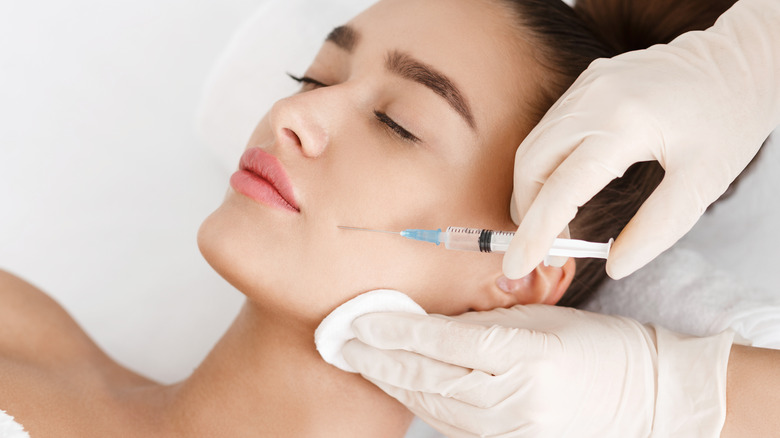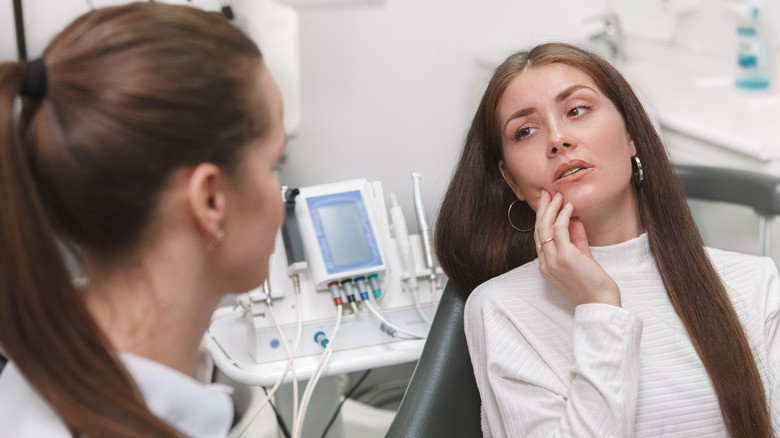Does Botox Help With Teeth Grinding?
Botox, the classic wrinkle smoother, has gotten attention for its potential use as a treatment for temporomandibular joint disorders, commonly referred to as TMD and TMJ interchangeably. This condition can be caused by lifestyle issues, such as sleeping too much on one side, uneven grinding of the teeth, or bone loss or malformation (via Byrdie). The Cleveland Clinic states that you're most likely to be diagnosed with TMD at the dentist, but observing your own jaw movements can help in terms of general assessment. The condition is most common in people ages 20 to 40, and is more frequently seen in women (per The Cleveland Clinic).
Both Allure and Byrdie praise the use of Botox injections to treat TMD. Journalists for each publication reported experiencing a short-term improvement in jaw pain and tightness following their respective Botox appointments. Byrdie cites a 2015 study titled "Temporomandibular Myofacial Pain Treated with Botulinum Toxin Injection," as well as a dermatologist, aesthetician, injection specialist, and plastic surgeon Dara Liotta, MD, to back up these findings.
Liotta told Byrdie, "Botox can be used ... functionally (to weaken the masseter muscle, which is the main teeth-grinding muscle, and improve the pain of TMD from teeth grinding)." The injection is a standard 25 units on each side of the jaw, and the entire treatment takes approximately five minutes. According to Liotta, the benefits of this treatment include no downtime post-injection, minimal swelling, and measurable results — such as decreased pain, headaches, or jaw tension — within a few weeks.
Botox may have long-term effects on the jaw
Despite the positive reports on Botox's effectiveness, there's controversy in the dental community surrounding the treatment, which indicates that its short-term effectiveness — typically a window of three to five months — leads to repeated treatments at higher doses. Additionally, researchers at NYU's College of Dentistry have stated that though there is no comprehensive study on the long-term effects of high-dose Botox usage in the jaw, the treatment has been linked to muscle atrophy and loss of jaw bone density.
Though Botox has yet to be approved by the FDA as a treatment for TMD(via Healthline), doctors continue to use it at patients' request. The Mayo Clinic cites other helpful treatments for TMD and teeth grinding, including pain relievers, anti-inflammatory medicines, muscle relaxants, and even certain antidepressants that can lessen discomfort. For non-medicinal routes, folks with TMD can also learn exercises, massage techniques, and relaxation techniques from their dental care team to reduce tension and strengthen muscles in the jaw. Icing and heating are also considered valid pain treatments, as well as acupuncture.
Unlike the Mayo Clinic, The Cleveland Clinic has Botulism Toxin, aka Botox, listed as a treatment for TMD. The website states, "These injections help reduce muscle mass and inflammation." Cleveland does also recommend a mouthguard to align your teeth and jaw, reducing your jaw's range of motion and keeping your teeth apart slightly when possible. They suggest placing your tongue on the roof of your mouth in order to relieve pressure on the jaw as another helpful trick.

